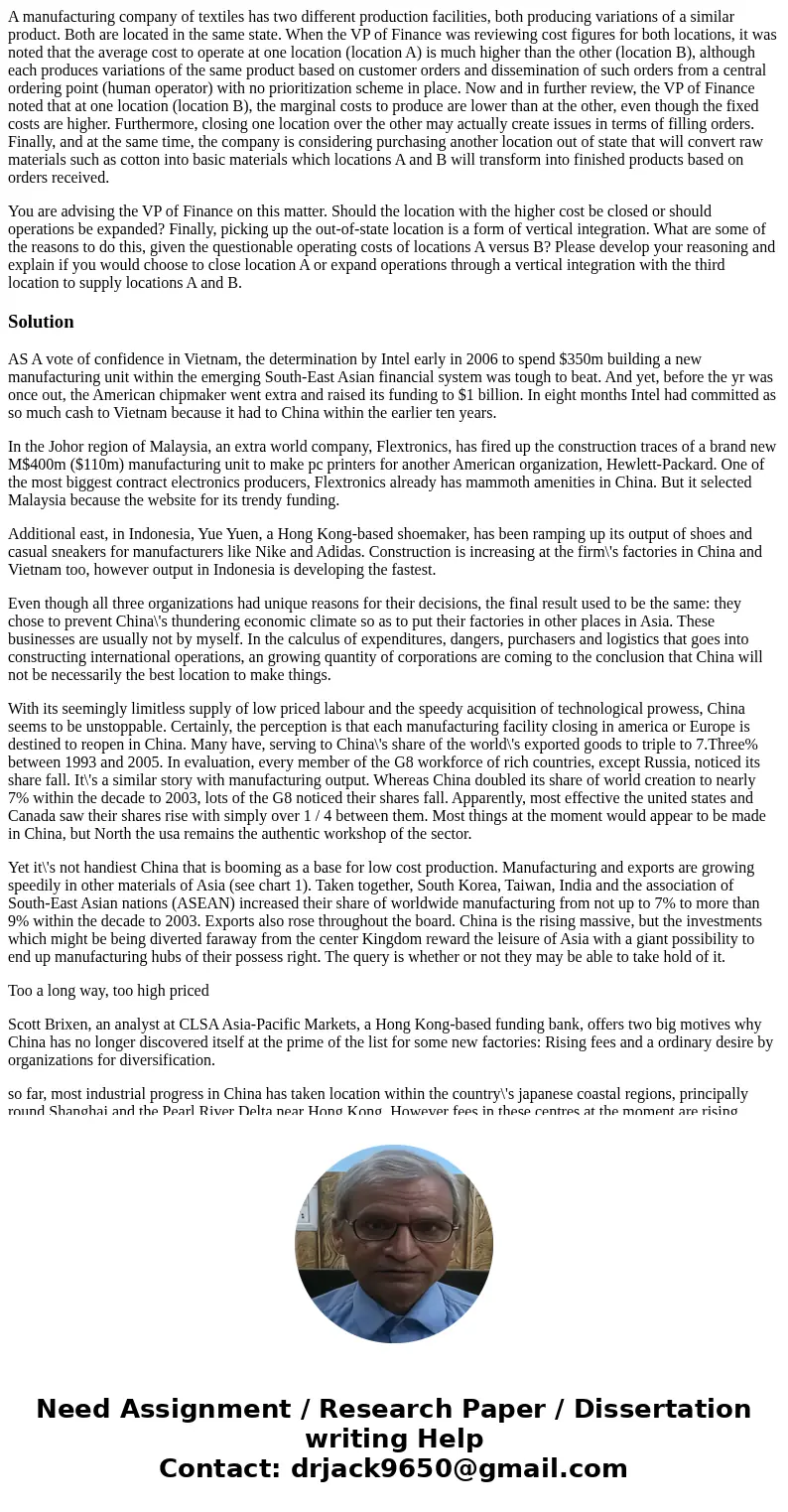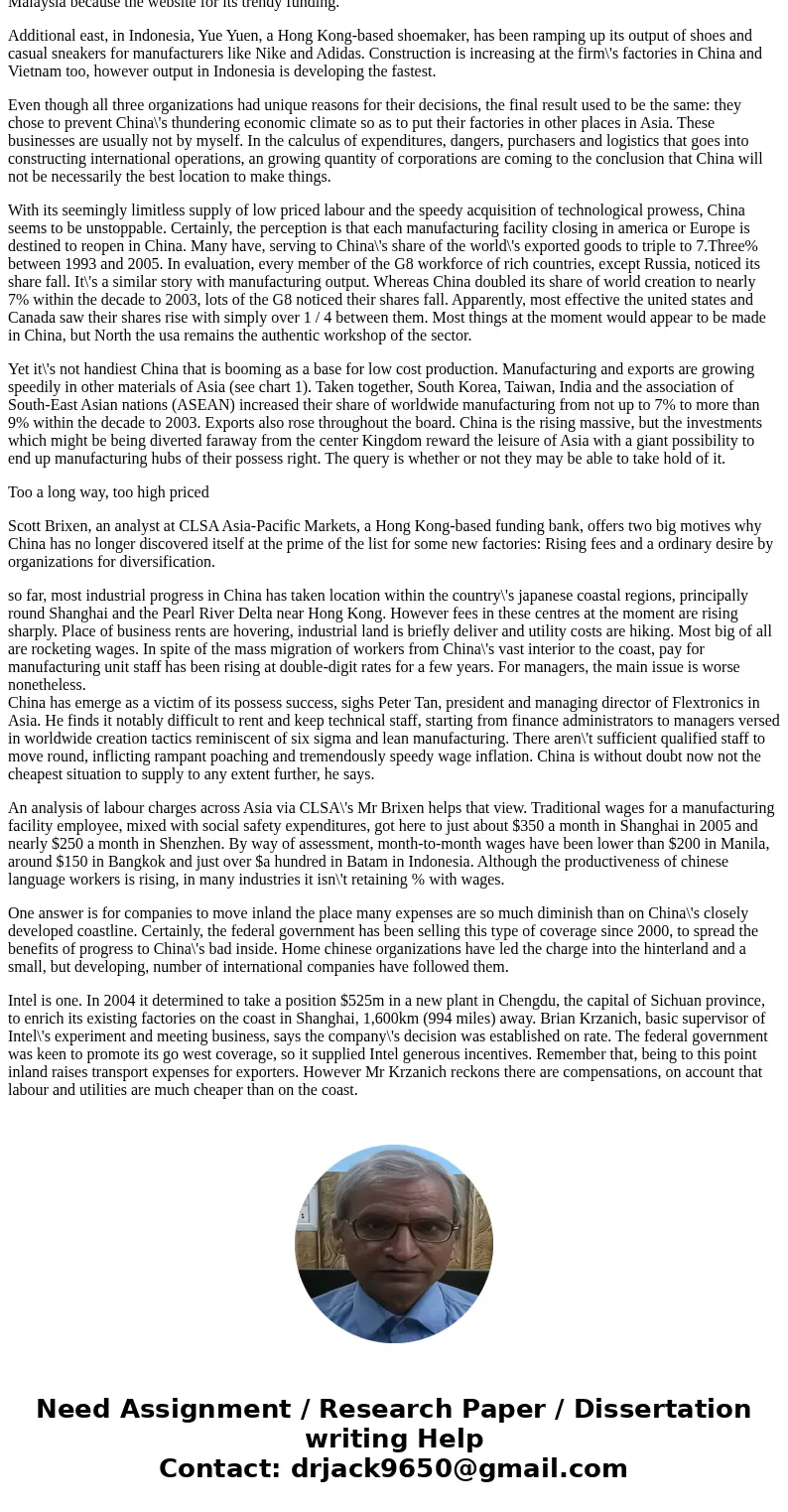A manufacturing company of textiles has two different produc
A manufacturing company of textiles has two different production facilities, both producing variations of a similar product. Both are located in the same state. When the VP of Finance was reviewing cost figures for both locations, it was noted that the average cost to operate at one location (location A) is much higher than the other (location B), although each produces variations of the same product based on customer orders and dissemination of such orders from a central ordering point (human operator) with no prioritization scheme in place. Now and in further review, the VP of Finance noted that at one location (location B), the marginal costs to produce are lower than at the other, even though the fixed costs are higher. Furthermore, closing one location over the other may actually create issues in terms of filling orders. Finally, and at the same time, the company is considering purchasing another location out of state that will convert raw materials such as cotton into basic materials which locations A and B will transform into finished products based on orders received.
You are advising the VP of Finance on this matter. Should the location with the higher cost be closed or should operations be expanded? Finally, picking up the out-of-state location is a form of vertical integration. What are some of the reasons to do this, given the questionable operating costs of locations A versus B? Please develop your reasoning and explain if you would choose to close location A or expand operations through a vertical integration with the third location to supply locations A and B.
Solution
AS A vote of confidence in Vietnam, the determination by Intel early in 2006 to spend $350m building a new manufacturing unit within the emerging South-East Asian financial system was tough to beat. And yet, before the yr was once out, the American chipmaker went extra and raised its funding to $1 billion. In eight months Intel had committed as so much cash to Vietnam because it had to China within the earlier ten years.
In the Johor region of Malaysia, an extra world company, Flextronics, has fired up the construction traces of a brand new M$400m ($110m) manufacturing unit to make pc printers for another American organization, Hewlett-Packard. One of the most biggest contract electronics producers, Flextronics already has mammoth amenities in China. But it selected Malaysia because the website for its trendy funding.
Additional east, in Indonesia, Yue Yuen, a Hong Kong-based shoemaker, has been ramping up its output of shoes and casual sneakers for manufacturers like Nike and Adidas. Construction is increasing at the firm\'s factories in China and Vietnam too, however output in Indonesia is developing the fastest.
Even though all three organizations had unique reasons for their decisions, the final result used to be the same: they chose to prevent China\'s thundering economic climate so as to put their factories in other places in Asia. These businesses are usually not by myself. In the calculus of expenditures, dangers, purchasers and logistics that goes into constructing international operations, an growing quantity of corporations are coming to the conclusion that China will not be necessarily the best location to make things.
With its seemingly limitless supply of low priced labour and the speedy acquisition of technological prowess, China seems to be unstoppable. Certainly, the perception is that each manufacturing facility closing in america or Europe is destined to reopen in China. Many have, serving to China\'s share of the world\'s exported goods to triple to 7.Three% between 1993 and 2005. In evaluation, every member of the G8 workforce of rich countries, except Russia, noticed its share fall. It\'s a similar story with manufacturing output. Whereas China doubled its share of world creation to nearly 7% within the decade to 2003, lots of the G8 noticed their shares fall. Apparently, most effective the united states and Canada saw their shares rise with simply over 1 / 4 between them. Most things at the moment would appear to be made in China, but North the usa remains the authentic workshop of the sector.
Yet it\'s not handiest China that is booming as a base for low cost production. Manufacturing and exports are growing speedily in other materials of Asia (see chart 1). Taken together, South Korea, Taiwan, India and the association of South-East Asian nations (ASEAN) increased their share of worldwide manufacturing from not up to 7% to more than 9% within the decade to 2003. Exports also rose throughout the board. China is the rising massive, but the investments which might be being diverted faraway from the center Kingdom reward the leisure of Asia with a giant possibility to end up manufacturing hubs of their possess right. The query is whether or not they may be able to take hold of it.
Too a long way, too high priced
Scott Brixen, an analyst at CLSA Asia-Pacific Markets, a Hong Kong-based funding bank, offers two big motives why China has no longer discovered itself at the prime of the list for some new factories: Rising fees and a ordinary desire by organizations for diversification.
so far, most industrial progress in China has taken location within the country\'s japanese coastal regions, principally round Shanghai and the Pearl River Delta near Hong Kong. However fees in these centres at the moment are rising sharply. Place of business rents are hovering, industrial land is briefly deliver and utility costs are hiking. Most big of all are rocketing wages. In spite of the mass migration of workers from China\'s vast interior to the coast, pay for manufacturing unit staff has been rising at double-digit rates for a few years. For managers, the main issue is worse nonetheless.
China has emerge as a victim of its possess success, sighs Peter Tan, president and managing director of Flextronics in Asia. He finds it notably difficult to rent and keep technical staff, starting from finance administrators to managers versed in worldwide creation tactics reminiscent of six sigma and lean manufacturing. There aren\'t sufficient qualified staff to move round, inflicting rampant poaching and tremendously speedy wage inflation. China is without doubt now not the cheapest situation to supply to any extent further, he says.
An analysis of labour charges across Asia via CLSA\'s Mr Brixen helps that view. Traditional wages for a manufacturing facility employee, mixed with social safety expenditures, got here to just about $350 a month in Shanghai in 2005 and nearly $250 a month in Shenzhen. By way of assessment, month-to-month wages have been lower than $200 in Manila, around $150 in Bangkok and just over $a hundred in Batam in Indonesia. Although the productiveness of chinese language workers is rising, in many industries it isn\'t retaining % with wages.
One answer is for companies to move inland the place many expenses are so much diminish than on China\'s closely developed coastline. Certainly, the federal government has been selling this type of coverage since 2000, to spread the benefits of progress to China\'s bad inside. Home chinese organizations have led the charge into the hinterland and a small, but developing, number of international companies have followed them.
Intel is one. In 2004 it determined to take a position $525m in a new plant in Chengdu, the capital of Sichuan province, to enrich its existing factories on the coast in Shanghai, 1,600km (994 miles) away. Brian Krzanich, basic supervisor of Intel\'s experiment and meeting business, says the company\'s decision was established on rate. The federal government was keen to promote its go west coverage, so it supplied Intel generous incentives. Remember that, being to this point inland raises transport expenses for exporters. However Mr Krzanich reckons there are compensations, on account that labour and utilities are much cheaper than on the coast.


 Homework Sourse
Homework Sourse